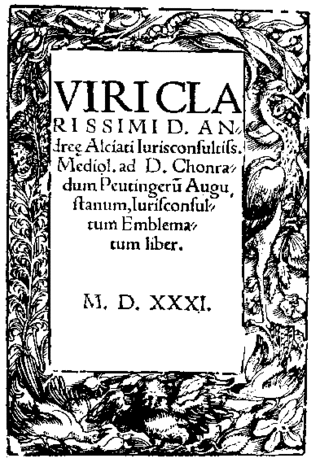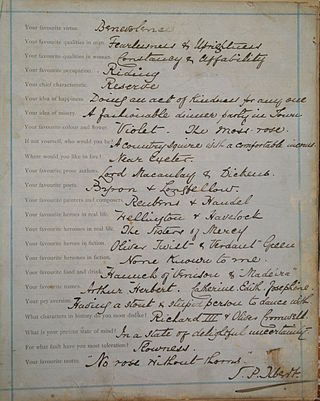
Andrea Alciato, commonly known as Alciati, was an Italian jurist and writer. He is regarded as the founder of the French school of legal humanists.
Friendship books are small booklets made by stapling paper together, or are sometimes just sheets or strips of paper. They are usually decorated and the person who starts the book writes their name and address as the first person sending the book. People often include a list of interests as well. The FB is then passed around from penpal to penpal, and can often also become a way for one to meet new penpals. Most people hope to see the book again once it is full so they add their return address to the back cover of the book too, or inscribe "Return to Sender" on it. People also sometimes make FBs for someone else rather than themselves, in which case they write the name and address of the recipient on the front/at the top. Some people find friendship books fun because you can see where they have been in a trail back to the original sender/recipient.

An emblem is an abstract or representational pictorial image that represents a concept, like a moral truth, or an allegory, or a person, like a monarch or saint.

An emblem book is a book collecting emblems with accompanying explanatory text, typically morals or poems. This category of books was popular in Europe during the 16th and 17th centuries.

Usually known simply as the Emblemata, the first emblem book appeared in Augsburg (Germany) in 1531 under the title Viri Clarissimi D. Andreae Alciati Iurisconsultiss. Mediol. Ad D. Chonradum Peutingerum Augustanum, Iurisconsultum Emblematum Liber. Produced by the publisher Heinrich Steyner, the unauthorized first print edition was compiled from a manuscript of Latin poems which the Italian jurist Andrea Alciato had dedicated to his friend Conrad Peutinger and circulated to his acquaintances. The 1531 edition was soon followed by a 1534 edition authorized by Alciato: published in Paris by Christian Wechel, this appeared under the title Andreae Alciati Emblematum Libellus. The word "emblemata" is simply the plural of the Greek word "emblema", meaning a piece of inlay or mosaic, or an ornament: in his preface to Peutinger, Alciato describes his emblems as a learned recreation, a pastime for humanists steeped in classical culture.

Paper marbling is a method of aqueous surface design, which can produce patterns similar to smooth marble or other kinds of stone. The patterns are the result of color floated on either plain water or a viscous solution known as size, and then carefully transferred to an absorbent surface, such as paper or fabric. Through several centuries, people have applied marbled materials to a variety of surfaces. It is often employed as a writing surface for calligraphy, and especially book covers and endpapers in bookbinding and stationery. Part of its appeal is that each print is a unique monotype.

Scrapbooking is a method of preserving, presenting and arranging personal and family history in the form of a book, box or card. Typical memorabilia include photographs, printed media, and artwork. Scrapbook albums are often decorated and frequently contain extensive journal entries or written descriptions. Scrapbooking started in the United Kingdom in the nineteenth century.

Scandinavism, also called Scandinavianism or pan-Scandinavianism, is an ideology that supports various degrees of cooperation among the Scandinavian countries. Scandinavism comprises the literary, linguistic and cultural movement that focuses on promoting a shared Scandinavian past, a shared cultural heritage, a common Scandinavian mythology and a common language or dialect continuum, and which led to the formation of joint periodicals and societies in support of Scandinavian literature and languages. Nordism expands the scope to include Iceland and Finland.

Philipp Hainhofer was a merchant, banker, diplomat and art collector in Augsburg. He is remembered, among other things, for the curiosity cabinets (Kunstschränke) which he created with the assistance of a large number of Augsburg artisans.
A photographic album or photo album, is a series of photographic prints collected by an individual person or family in the form of a book. Some book-form photo albums have compartments which the photos may be slipped into; other albums have heavy paper with an abrasive surface covered with clear plastic sheets, on which surface photos can be put. Older style albums often were simply books of heavy paper on which photos could be glued to or attached to with adhesive corners or pages.

The Danish Golden Age covers a period of exceptional creative production in Denmark, especially during the first half of the 19th century. Although Copenhagen had suffered from fires, bombardment and national bankruptcy, the arts took on a new period of creativity catalysed by Romanticism from Germany. The period is probably most commonly associated with the Golden Age of Danish Painting from 1800 to around 1850 which encompasses the work of Christoffer Wilhelm Eckersberg and his students, including Wilhelm Bendz, Christen Købke, Martinus Rørbye, Constantin Hansen and Wilhelm Marstrand, as well as the sculpture of Bertel Thorvaldsen.

The confession album, or confession book, was a kind of autograph book popular in late-nineteenth-century Britain. Instead of leaving free room for invented or remembered poetry, it provided a formulaic catechism. The genre died out towards the end of the century, with occasional brief revivals in the twentieth century. The same kind of form is now found in the Dutch vriendenboek, and German Freundschaftsbuch, used by small children; and the questions that the confession album contained live on in the Proust Questionnaire often used for celebrity interviews.

The Walnut Tree is one of Aesop's fables and numbered 250 in the Perry Index. It later served as a base for a misogynistic proverb, which encourages the violence against walnut trees, asses and women.
The Two Pots is one of Aesop's Fables and numbered 378 in the Perry Index. The fable may stem from proverbial sources.
The Gourd and the Palm-tree is a rare fable of West Asian origin that was first recorded in Europe in the Middle Ages. In the Renaissance a variant appeared in which a pine took the palm-tree's place and the story was occasionally counted as one of Aesop's Fables..

Lambert de Vos was a Flemish painter and draughtsman from Mechelen who travelled to Constantinople to work for the diplomatic mission of the Habsburg Empire. Here he made a number of drawings of the various local costumes and some of the architectural sights. His drawings serve as an important source of information on the dress of people living in the Turkish empire and the architecture of Constantinople during his residence.

"The Blind Man and the Lame" is a fable that recounts how two individuals collaborate in an effort to overcome their respective disabilities. The theme is first attested in Greek about the first century BCE. Stories with this feature occur in Asia, Europe and North America.

The Elm and the Vine were associated particularly by Latin authors. Because pruned elm trees acted as vine supports, this was taken as a symbol of marriage and imagery connected with their pairing also became common in Renaissance literature. Various fables were created out of their association in both Classical and later times. Although Aesop was not credited with these formerly, later fables hint at his authorship.
Developed by authors during Renaissance times, the story of an ass eating thistles was a late addition to collections of Aesop's Fables. Beginning as a condemnation of miserly behaviour, it eventually was taken to demonstrate how preferences differ.

The album amicorum was an early form of the poetry book, the autograph book and the modern friendship book. It emerged during the Reformation period, during which it was popular to collect autographs from noted reformers. In the 1700s, the trend of the friendship book was still mainly limited to the Protestant people, as opposed to the Catholics. These books were particularly popular with university students into the early decades of the 19th century. Noteworthy are the pre-printed pages of a friendship book from 1770 onwards, published as a loose-leaf collection by the bookbinder and pressman Johannes Carl Wiederhold (1743-1826) from Göttingen.

















